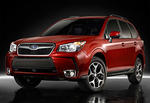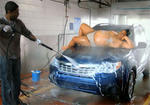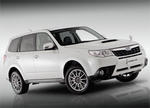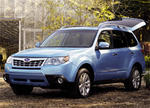
Subaru announced the details of the 2009 Subaru Forester in UK. The 2009 Subaru Forester will go on sale in UK this month and will be powered by a new 2.0 liter petrol engine developing 150 PS at 6,000 rpm and 144.6 lb ft of torque at 3,200 rpm. The 2009 Subaru Forester price for the UK market starts at £17,995 for the 2.0X manual version and goes up to £22,895 for the top of the line 2.0XS automatic.
Subaru Press Release:
COMPLETELY NEW FORESTER – THE DRIVER’S CHOICE
- Completely new Forester offers SUV space plus agile handling
- Closer in size to Toyota RAV4 and Honda CR-V
- New multi-link rear suspension gives ultra-smooth ride
- Higher ground clearance yet lower ‘boxer’ engine
- All-wheel drive plus Subaru Vehicle Dynamics Control for limpet grip
- Improved 2.0 liter petrol fuel economy
- Unbeatable standard equipment includes: AWD with Subaru Vehicle Dynamics Control, self-levelling rear suspension, cruise-control, climate-control airconditioning, radio/CD player, height and reach


steering wheel adjustment, foglamps, heated front seats, mirrors and windscreen wipers, front and rear electric windows, driver, passenger, side and curtain airbags plus vehicle information display
- Forester 2.0X and XS petrol manual automatic available from April
- Prices start at £17,995 for Forester 2.0X manual
A completely new Forester goes on sale in April offering more space, a smoother ride, greater ground clearance yet even more agile handling, fully justifying Subaru’s adherence to the low centre-of-gravity ‘boxer’ engine and all-wheel drive system which has made the brand famous.
Even more the keen driver’s choice, the new Forester is Subaru’s third generation of crossover SUVs but now occupies a similar silhouette to the Toyota RAV4, Nissan X-Trail or Honda CR-V.
Based on the platform of the new Impreza, the Forester features a new multi-link rear suspension, fuel-saving electric power steering, standard Subaru Vehicle Dynamics Control, self-levelling rear suspension, engine efficiency improvements and a revised automatic transmission offering ‘normal’, ‘sports’ or ‘manual’ mode.
Now closer in size to its less agile SUV competitors, the completely new Forester is 75 mm longer, 45 mm wider and gains 110 mm in height.
Rear legroom grows by 95 mm, the driver’s eye-line is 30 mm higher, while the load space is now 450 litres with the rear seat up – 63 litres more than the previous model.
It also enjoys enhanced fuel economy and driveability thanks to an improved 2.0 litre petrol ‘boxer’ engine which – having its cylinders horizontally-opposed – gives the car a lower centre of gravity for improved grip, reduced body roll and more precise steering response.
This is further aided by the engine and transmission now being placed 10 mm lower in the platform.
The Forester 2.0X and 2.0XS petrol models are available from April costing £17,995 and £21,895 on-the-road respectively in manual form. Expected to be the bigger sellers, automatic versions add a £1,000 premium.
Launched in Japan on December 25 last year, the completely new Forester found 4,285 customers in the first 30-plus days of going on sale – 2,000 more then expected – while January registrations were 136 per cent up on the previous year.
Equipment And Design
The new Forester boasts outstanding equipment with even the entry-level Forester 2.0X
featuring: symmetrical all-wheel drive; Subaru Vehicle Dynamics Control; self-levelling rear
suspension; fuel-saving electric power steering; front, side and curtain airbags; four
electric windows; 60/40-split rear seats with reclining back-rests; climate-control airconditioning;
radio/CD player; front fog lamps; vehicle information display; height and
reach-adjustment steering wheel; heated front seats, mirrors and windscreen wipers plus
cruise-control. Manual models feature a dual-range transmission.
The higher-spec Forester 2.0XS adds: alloy wheels; leather seats, steering wheel, gearlever
and handbrake; premium audio system featuring a six-stacker CD-player and seven
speakers; HID headlamps; sun-roof; electrically-powered driver’s seat; retractable rear
seat tray with cup-holder; engine starter button and ‘smart’ entry.
Other premium touches include a gas strut-assisted bonnet, flowing fascia design, doublestitched
seat cloth, metallic interior decoration and padded armrest cushions.
The instruments are also sporty thanks to their clear design and subtle lighting while the
extensive vehicle information display includes a fuel consumption indicator highlighting the
new Forester’s much improved efficiency.
Now, much more SUV-like in appearance, the new Forester boasts a clean, chiselled
appearance with multi-grooved wheel-arches, hawk-eye headlamps and aggressive
bumpers. Thought has even been given to the chunky exterior door handles which have
deep recesses to allow winter glove-wearers an easier grip.
New 2.0 Litre Engine In Detail
The new Forester 2.0X and XS enjoy substantial revisions to their 2.0 litre ‘boxer’ engines
which result in stronger low and mid-range pulling power, enhanced flexibility and
improved fuel economy with lower exhaust emissions.
Power is now 150 PS at 6,000 rpm while torque is 7.4 lb ft (10 Nm) greater, recording
144.6 lb ft at 3,200 rpm.
The result is an improvement of more than 3 mpg on the Combined cycle for the
automatic, with exhaust emissions down by 21 g/km.
Urban/Extra Urban and Combined fuel consumption are now 25.2/40.9 and
33.6 mpg for the Forester 2.0 X and XS automatic with a CO2 reading of 199 g/km.
This compares favourably with the petrol automatic competition. The new Forester is 4
mpg better than the Nissan X-Trail and 2 mpg ahead of the Toyota RAV4 while emitting
significantly less CO2.
The 0-60 mph is 12.3 seconds with a maximum speed of 115 mph while improved torque
allows higher gearing for improved refinement and economy with no sacrifice in engine
response.
Manual versions of the new Forester show similar improvements with Urban/Extra Urban
and Combined figures of 25.9/40.4 and 33.6 mpg with a low CO2 rating of 198 g/km. Top
speed for the manual Forester is 114 mph with a 0-60 mph time of 10.6 seconds.
The new Forester features twin overhead camshafts per bank (DOHC), four valves per
cylinder and an Active Valve Control System (AVCS) which is a form of variable valve
timing. This enhances both low-speed torque and high-rev power.
In addition, the combustion chambers have been redesigned for increased tumble gas flow
for reduced fuel consumption. Also for improved efficiency are a revised intake system,
cooling system and catalytic converters.
The new 2.0 litre four-cam ‘boxer’ engine retains the same 92 mm bore and 75 mm stroke
as before but with a lower 10.2:1 compression ratio.
Improved Automatic Transmission
The new Forester’s four-speed automatic transmission provides smoother
changes with greater sensitivity to the driver’s wishes.
It is more efficient, saving fuel, because a slip lock-up device reduces wasted
engine revs. In addition, advanced electronics – linked to an electronic throttle –
match engine speed with the best gear for any given situation.
A new feature is ‘Sports Shift’ which allows the driver to select from ‘normal’,
‘sports’ or ‘manual’ control, allowing him or her to ‘tap-shift’ gears at will.
As with previous models, the full-time all-wheel drive transmission features a
60/40 Active Torque-Split on the automatic. However, the split varies according
to changing conditions.
Both automatic and manual versions of the new Forester now benefit from
Subaru Vehicle Dynamics Control as standard.
This advanced system uses sophisticated sensors to detect side to side and
front to rear slip plus sudden steering movements. It controls
oversteer/understeer and potential loss of control by braking individual wheels
and cutting engine revs – all in milliseconds.
Slicker-Shifting Manual
Manual models benefit from a slicker-shifting gearchange with both lighter movements and
reduced internal friction which improves fuel consumption.
As with previous models, dual-range transmission is standard on manual cars providing,
effectively, 10 speeds. Dual range is selected by depressing the clutch and raising a small
lever next to the gear-shift. This can be done on the move.
Low-ratio advantages include extra control through enhanced engine braking in slippery
conditions. This could be while driving down a snow-lined street littered with abandoned
cars or while pulling a caravan off a rain-soaked field.
The Forester’s quick-thinking full-time AWD system on manual models splits power 50/50
front to rear. However, as soon as slip is detected, the centre differential with its viscouscoupling
distributes torque to the axle with the most grip. This happens in milliseconds.
Passenger And Pedestrian Safety Boost
Both occupants and pedestrians are well protected by the new Forester thanks to a whole
series of safety measures aimed at achieving the highest standards of both occupant and
pedestrian safety.
Curtain and side airbags are now fitted to all models together with driver and passenger
airbags. The front seatbelts have pre-tensioners, anti-whiplash front head restraints are
standard and the front seats have energy-absorbing backs.
The brake pedal is energy-absorbing, being designed to snap away under severe impact,
protecting the driver’s lower limbs. In the rear seat are two ISOFIX-compatible child seat
mountings.
The passenger airbag is dual-stage which provides progressive protection matched to the
severity of the impact and the standard anti-lock brakes (ABS) come with electronic
brakeforce distribution (EBD). This juggles the braking force between front and rear
wheels according to load shifts during deceleration. Unlike the previous model, the new
Forester has front ventilated disc brakes and solid rear discs.
High tensile steel of varying thickness is used extensively throughout the body, providing
good crushability where needed while protecting the passenger area.
Not only does the elimination of the previous Forester’s front subframe reduce body weight
by 20 kg but the new structure better dissipates front impact forces.
Much careful thought has been given to enhance pedestrian protection. Because the
Forester is higher than a car, more space has been made between the bonnet and catch,
while the bonnet itself has been designed to spread impact load over its entire surface.
The rear of the bonnet compresses easily and the cowl ahead of the windscreen is
designed to dissipate collision energy.
A new shock-absorbing plate has been installed ahead of the front bumper beam to
reduce pedestrian leg injuries. This new design meets European pedestrian safety
regulations while retaining the off-road approach angle expected of an SUV.
Outstanding Ride Plus Driver-Focussed Handling
A sophisticated all-wheel drive system coupled with low-friction, long travel four-wheel
independent suspension and low-centre of gravity ‘boxer’ engines have all contributed to
the Forester’s reputation for outstanding chassis dynamics – far removed from
conventional SUVs.
Now for the new model, Subaru has devised a completely new platform with a 90 mm
longer wheelbase, tracks widened by 35 mm front and 45 mm rear and a sophisticated
multi-link, double wishbone rear suspension.
In addition, to further improve handling and roadholding, the position of the ‘boxer’ engine
has been dropped by 10 mm, lowering the centre of gravity still further.
Other changes include a new fuel-saving electric power steering system with more rigid
mounting and new design of MacPherson strut front suspension.
The result is a highly-absorbent ride with precise geometry control for accurate
straight-line running over uneven road surfaces backed by extremely responsive
steering and handling.
The rear multi-link, double wishbone suspension liberates more luggage space thanks to
its compactness compared to the previous rear strut arrangement.
And because it is attached to a sub frame via bushes, with the mounting section moved to
under the floor itself, road noise is reduced.
The rear springs and shock-absorbers are mounted behind the centre-line of the rear
wheels, with the wheel stroke itself moving rearwards – all helping ride comfort. A rear
anti-roll bar is standard.
Like all previous Foresters, the rear suspension features self-levelling which aids stability
when laden and ensures a constant ground clearance – now a substantial 215 mm – 10
mm greater than before.
At the front, the previous sub frame has been eliminated, saving 20 kg in body weight yet a
new box-section for the front cross-member provides the same level of rigidity.
The new MacPherson strut and anti-roll bar layout is based on that used by the highlypraised
Legacy and new Impreza. It offers high lateral rigidity which improves steering
response and cornering stability.
This is further enhanced by an especially rigid mounting for the steering rack and the
positioning of the steering gearbox and electric motor below the rack for a more consistent
feel. Furthermore, special suspension bushes and attachment points reduce road shock.
The steering gear ratio has been changed for a sportier feel while the rack diameter is
increased from 23 to 26 mm. The result is a more linear feel to steering inputs.
Wheel and tyre sizes have been optimised for the new Forester’s chassis and anticipated
all-terrain use.
The Forester 2.0X features 16 x 6.5 ins steel wheels with alloy look trims while the
Forester 2.0XS has alloy wheels in the same size. Both models feature 215/65 R16 tyres.
Generous Warranty
All Foresters marketed by Subaru (UK) Limited come with the reassurance of a three year
or 60,000 mile warranty plus 12 year anti-corrosion cover and three year paintwork
warranty.
This is in addition to three years’ membership of Subaru Assistance – a comprehensive
home and roadside repair and recovery package throughout the UK and Europe
administered by Mondial Assistance. Service intervals are 12,000 miles or one year –
whichever arrives first.
The new Forester range is as follows:
On-The-Road
2.0X manual £17,995
2.0XS manual £21,895
2.0X automatic £18,995
2.0XS automatic £22,895
















